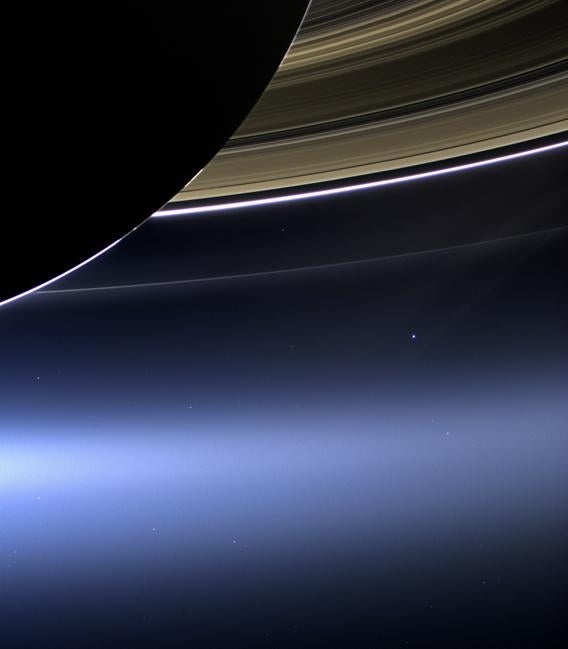This is nothing short of stunning: Two spacecraft on nearly opposite sides of the solar system both took pictures of the Earth at nearly the same time, showing our entire planet as not much more than a smeared flash of slightly overexposed light.
The picture above is from the Cassini spacecraft orbiting Saturn. On July 19, at a distance of 1.4 billion kilometers (900 million miles) from Earth, it took the above image (actually a combination of three pictures taken with a red, green, and blue filter to mimic a “natural light” photo). Cassini was on the far side of Saturn, looking back toward the inner solar system. From that vantage, Saturn blocks the Sun and looks dark (except for an arc of light scattered through its upper atmosphere), and we see the rings translucently, light from the distant Sun penetrating and shining through. The Earth is just under the main rings, a scintillation of blue above Saturn’s ghostly E-ring.
There’s more than just the Earth, too. The Moon is visible in the zoomed shot:

Photo by NASA/JPL-Caltech/Space Science Institute
A full description of how this image was taken is on the NASA site as well as the Cassini CICLOPS site.
These images from Cassini are only one part of a massive 33-picture mosaic that will show all of Saturn and its rings in full color; that image will be released soon. Stay tuned for that, because it will be magnificent.
Also on July 19, from only 50 million kilometers (30 million miles) from the Sun, the Messenger spacecraft orbiting Mercury took a fantastic shot of our home world and its moon:

Photo by NASA/Johns Hopkins University Applied Physics Laboratory/Carnegie Institution of Washington
The arrow indicates the pair. At the bottom in the middle is a zoomed version. On the left is a computer simulation of Messenger’s view of Earth at the time, and on the right the Moon. Messenger took this image just one day before the 44th anniversary of the first landing of humans on the Moon, and as a tip-of-the-hat the Apollo landing sites are indicated.
Even as I write this I am in awe of these images. The things I see in them are overwhelming. Think on this:
- Every human being who ever lived, in all of history, is contained in those images.
- The farthest any human being has ever traveled—every explorer who has climbed to a mountaintop, or dived to the deepest trench—is contained in those images. The farthest we humans have ever explored, to just beyond our own Moon—more than three days worth of travel at very high speed—is just a few pixels in these pictures.
- The Earth itself is a mere pixel here. Even in the zoomed Cassini picture, the Earth is barely larger than a single pixel in size.
Messenger took its image as part of a campaign to look for any natural satellites of Mercury. It is specially designed to withstand the much higher temperatures in the solar system near the Sun. Cassini, on the other hand, is so far from the Sun it had to be built to withstand the frigid environment of the outer solar system. Yet both spacecraft are doing essentially the same mission: extend our reach, our senses, to other worlds in our solar system, and to add to our knowledge and understanding of the Universe in which we live.
And yet the legacy of these images may be the smallness, the shining insignificance and singular beauty of our planet hanging in the depths of space. Context matters. We send our robot proxies into the terrible vastness, and when they turn them around to look back at us we see ourselves for who and what we really are. We’re part of that Universe, and it’s an outstanding achievement even being able to acknowledge that.
[Update (July 24, 2013 at 03:30 UTC): I meant to link to Carl Sagan’s essay “Reflections on a Mote of Dust”, commonly called “Pale Blue Dot”, in the item about all humans being in that photo, but it got past me when I posted this article. I was reminded when Wil Wheaton tweeted a link to this post, so I added the link above. My apologies.]
